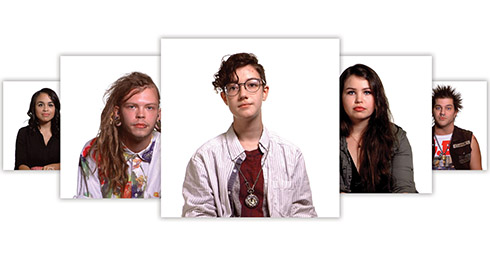
The Intersection of I showcases views on racialized identity.
The Storyscapes section of the Tribeca Film Festival, where installations, VR and interactive web projects mingle, frontally featured realities of a racialized society, in The Argus Project and Intersection of I.
Argus.
The Argus Project, by Gan Golan and his team, is designed to inspire citizens to do counter-surveillance against a police force constantly surveilling them. (Argus was a 100-eyed Greek god.) A fully armored statue of a police officer, studded with sensors and cameras, stands at the entrance to a three-screen surround experience, of victims’ relatives talking about police violence and murder.
Golan was inspired to the theme by suffering a false arrest during a protest. “It was only because someone had a recording of the incident, plus I was white and had resources, that I was freed and able to sue the police force (and win),” he said.
Ligaiya Romero, who conducted interviews and edited video for the project, said that balancing the three screens, and turning the narrative into a surround experience was challenging. More challenging, though, were her interviews with subjects likely to be suffering PTSD: “What is our responsibility to these people, and do we have a right to guide people through conversations about trauma? I found it was important for me to make sure they knew they were completely in control of the conversations.”
They hope to take the project into communities, to spur discussion of community policing and citizen activism, including with the organization Families United 4 Justice.
Whiteness Project.
Whitney Dow’s The Intersection of I is the next and more nuanced phase of his Whiteness Project. The installation, a version of which is available online, features short videos with millennials on their attitudes toward their whiteness, a pinwheel of photographs of skin colors, all of which belong to people who think they are white, and bold factoids about race, inequality and injustice.
“The racial conversation has moved forward significantly in the last 18 months,” Dow said. “They are hungry to have this conversation, there hasn’t been a framework to have it. White people don’t even know how to begin it.” The goal of the project, he said, “just to move people to the realization that they are having a racialized experience, just like everyone else. Then you can start talking to people of other races about issues. But if you think their world is impacted by their race but yours isn’t, you can’t get anywhere.”
Dow first made his reputation in longform docs, but now finds shortform, fueled by social media, to be the exciting place to be. For one, it’s the way to meet people who aren’t already comfortable with the issue. For another, it’s reaching people far beyond the moviegoing audience. Dow is working with social media platforms to produce short, evanescent work.
“I’m not upset about the idea of the media work disappearing in 24 hours,” he said. “All the media I make is a byproduct of my work making connections and sharing insights. I’m having a conversation; it’s not a destination.”
Dow said he’s faced a lot of hate from other white people. “ People want to individualize structural racism. They think admitting white privilege is an admission of guilt. It’s not, it’s a descriptor, and once you see it’s structural it’s hugely empowering. Suddenly you see shockingly easy opportunities all over the place to change dynamics of relationships every day.”
